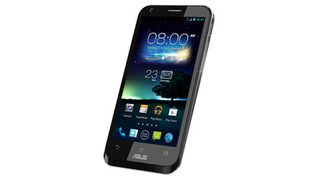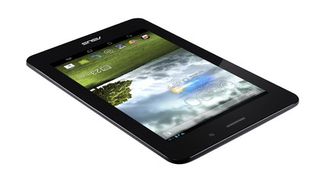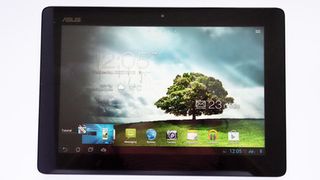Beyond that, comparing the gaming performance of the Padfone 2 and the Asus FonePad acts as a fine barometer for their relative hardware merits. After all, nothing puts a phone's innards to the test like a modern 3D game.
A performance comparison is especially interesting because the Asus Padfone 2 and the Asus FonePad, despite being produced by the same company at around the same time, could scarcely be more different internally.

While the Padfone 2 is built on a fairly typical - though also very capable - quad-core Qualcomm CPU and Adreno 320 GPU combo with 2GB of RAM, the FonePad takes a very different approach.
It's built on an Intel Atom Z2420 processor, which uses PC-like Hyper-Threading rather than multiple cores. It's backed by the slightly creaky PowerVR SGX540 GPU and a relatively meagre 1GB of RAM.
Comparing the two using the Antutu benchmarking tool, which provides a number of graphics-intensive (both 2D and 3D) tasks for Android devices to run through, there's a clear winner. With an average score of 21,607, the Padfone 2 more than doubled the 9,208 average score of the FonePad.
This apparent doubling in performance is understandable. While the Qualcomm chip is a premium component, the Intel processor is intended for relatively low-cost devices. Sure enough the FonePad can be had for about a third of the price of the Padfone 2.

If you're after something that will be able to run high-end games both now and into the future, the Padfone 2 is a better bet - if you can spare the £600/US$720/AU$750 it will take to obtain it.
Get daily insight, inspiration and deals in your inbox
Get the hottest deals available in your inbox plus news, reviews, opinion, analysis and more from the TechRadar team.
Otherwise, the FonePad will run pretty much anything currently available reasonably well - even advanced 3D games such as Real Racing 3 - and you'll pay just £180/AU$315 (around US$275) for the privilege.
Padfone 2 vs FonePad: Multimedia
The first thing to note is that both devices name the Google Play Store as the main source for their media. Through this increasingly impressive online media library you can get access to thousands of cheap video rentals and the comprehensive Google Books.
We'd prefer to watch a video and read a book on the Asus FonePad than on the Padfone 2, though. It's down to the difference in screen dimensions.
The FonePad's 7-inch 1280 x 800 display simply makes for a clearer and more engaging experience than Padfone 2's 4.7-inch equivalent.
The latter may be a little brighter and sharper, but the extra two inches of screen real estate more than makes up for that when watching a widescreen blockbuster or settling down to read a sprawling novel.

Obviously the Padfone 2 also has that 10.1-inch tablet adaptor, but with no increase in resolution and an inferior picture, both video and text can look a little grainy and washed out when blown up to such a size. It really offers little advantage.
Storage is another issue here. While the FonePad is only available with 8 or 16GB of internal storage compared to the Padfone 2's 16, 32, or 64GB, the former has the massive advantage of a microSD card slot. Not only does this open up the possibility for an extra 64GB of cheap memory expansion, it also offers another way to get media onto your tablet from other devices.
Padfone 2 vs FonePad: Internet
Once again, Google provides the default arrangements for internet software here in the shape of Chrome. It's a brilliant mobile browser, with its minimalistic interface, intuitive use of multiple tabs and ability to sync bookmarks with the desktop equivalent.
The respective screens play a big part in deciding which internet experience is preferable here. Once again, the Padfone 2's sub-par tablet component lets it down somewhat, compromising the full-size internet experience with its fuzzy, dim picture.
Most Popular




